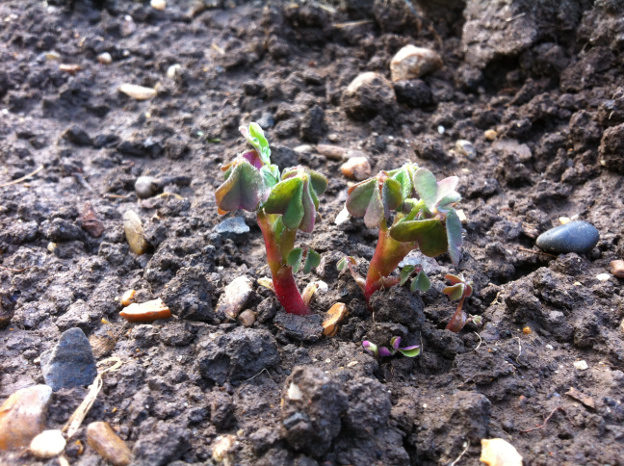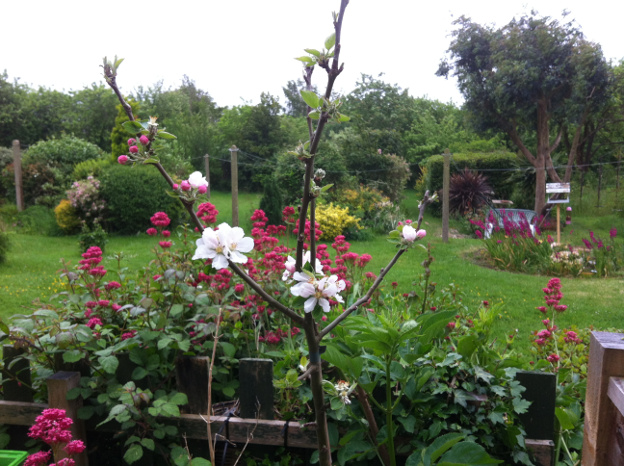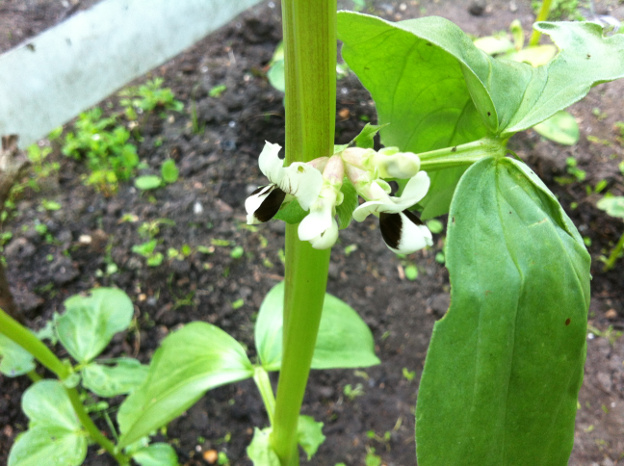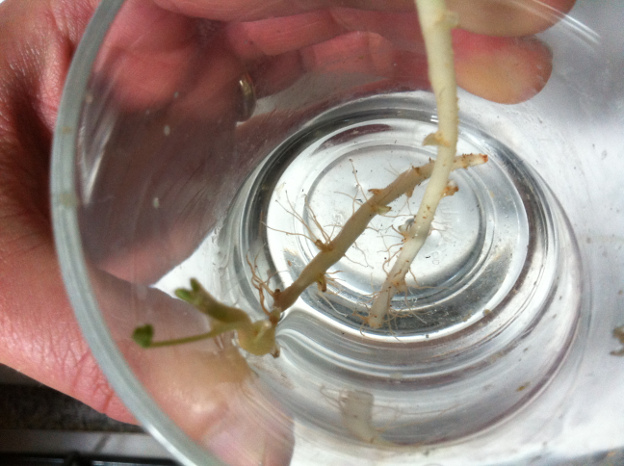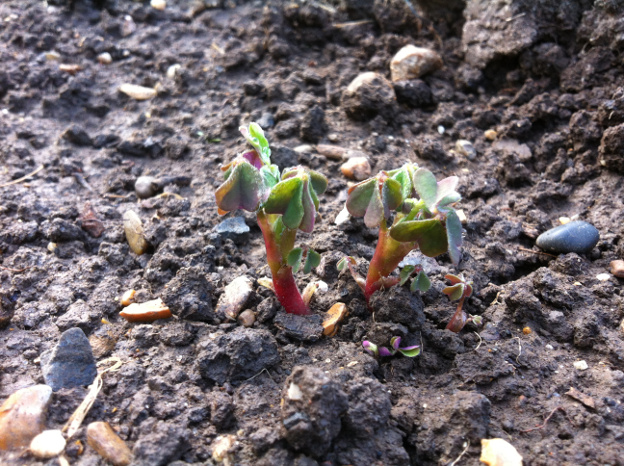It’s been nearly three weeks since our last post and a lot has changed since then. Shortly after going to press our young Court Pendu Plat apple came into bloom. As noted in our last post, this tree was historically known as ‘the wise apple’, because it blossoms so late in the season that it never loses its blossom to late frosts.
This then signified that it was time for our mostly hardened off tomatoes and curcubits to be planted out into the miscellaneous crops bed. But then disaster struck. In quick succession strong winds and unexpected hot weather devastated some of our more mature plants. We had a very large, if a little leggy, patty pan plant which was snapped in two in the strong winds. The same winds also left some of our tomato plants with very few unscathed leaves.
A couple of days later the forecast was for an overcast day. We had plans in the morning and we were so focused on getting the children ready and out of the door that we didn’t find time to get the plants out of our small plastic greenhouse before we left. It wasn’t that we forgot, just that we were in a hurry and as it was rather cold for the time of year, and the forecast predicted that it would stay that way all day, we decided to get them out upon our return around lunchtime.
However, by the time we came back at lunchtime it was like a summer’s day and we found many of the plants in the greenhouse withered. We soaked the pots and removed them from the heat of the greenhouse. Some of the plants recovered, but many didn’t. And so some of our plans suffered somewhat of a setback. To make matters worse we also lost two of our less mature courgette plants, and one small pumpkin plant to snails in the small greenhouse in the nights that followed.
We’ve planted more patty pans and courgettes, and we had planted more than enough tomato plants in the first place, it was just a shame to see so much loss amongst our more mature specimens. But it hasn’t been all doom and gloom. Despite the slugs’ best efforts, our legumes bed is currently looking quite healthy.
Unfortunately a few of our Boddington’s Soup Peas in were lost in the greenhouse disaster. This was particularly frustrating as it really wasn’t necessary for them to be in there, we only put them in there to reduce the likelihood of them being eaten by slugs and snails. But we have since planted more (we like to get the plants established before we plant them out, the slugs and snails wouldn’t give them a chance if we germinated them in their final bed).
We have a few of these pea plants well established in the legumes bed, and the others we sowed after the greenhouse incident are almost ready to be planted out. Our Martock field beans are also doing quite well. We completely lost one plant to predators, and another was so weakened that we decided that it should be replaced with one of the ones we had grown in pots as reserves. But I am pleased to say that they are now in flower and we are eagerly looking forward to our first beans from this historic crop.
Not quite living up to expectations at the moment is our first foray into growing quinoa. We sowed our first seeds many weeks ago and were very excited by the germination rate. However, the majority of these germinated seeds died. The few that survived have mostly stayed as being seedlings and grown very little. Our neighbours are convinced it is due to the unseasonably cool weather we’ve been having.
Reluctant to write this attempt off as a failure, we have since sown another batch of seeds and these have now germinated. The survival rate remains to be seen, but we have reserved a space in the roots patch (last year’s pumpkin patch) for these. If nothing comes of them we plan to sow carrots or beetroots there. But for now we are still hoping there is a chance of quinoa.
Far more encouraging has been our first attempt at growing oca. So far these South American tubers are looking quite healthy, just a little immature. We let them get a little leggy whilst chitting them, they should probably have had more light. We had intended to plant them out far sooner than we actually did, but the instructions on the packaging said that the shoots would die back if they experienced frosts. So we waited until our apple tree told us the time had come. During which time they got a bit leggy, as the photo above shows.
We planted a row of oca in our roots bed, the tubers planted one foot (30cm) apart, and the row is sitting in between a row of potatoes and a row of leeks. A couple of the shoots snapped off of the tubers, but the instructions said that if this happened they could be rooted in a glass of water, so we attempted this with the two shoots.
Within a couple of days there appeared to be some small roots forming, and the white shoots started to turn a purple colour at their tips. Just over a week later they had grown some healthy looking roots and the tips had taken on a healthy colour. So we moved these into the spaces we had reserved for them in the row of oca in the roots patch.
Within a few days of planting the tubers out we started to see the shoots poking through the soil. We didn’t bury them very deep. The instructions said to ‘earth them up’ like potatoes, so we planted them in a trench and covered the tips of the shoots with about half an inch of soil. We are very pleased with how these are looking at the moment. The following photo was taken about a week and a half after we planted them. We’ll let them get a little more established before we earth them up, but we are very happy with the progress they are making.
Speaking of making progress, my idea of using an area by the large vegetable patch as a soft fruit patch, which I probably first suggested about a year ago, is almost complete. However, it’s no longer going to be a soft fruit patch as such, more of a perennial fruit patch. I posted last year that we sowed three rhubarb seeds in pots, and that all three germinated and were looking healthy. Well back in April I planted these out into the area that was going to be the soft fruits patch.
More recently I planted out our (perennially neglected) potted redcurrant bush into this patch. I had planned to also plant some gooseberry bushes here, but having planted the three rhubarb plants and the redcurrant bush, I don’t think there’s going to be room. It would make more sense to use the remaining vacant space for our (also perennially neglected) blackcurrant bush, as this is in urgent need of being moved from the pot that it has outgrown.

Our perennial fruits patch is now taking shape. It is currently home to three rhubarb plants and a redcurrant bush.
In case you were wondering what the mulch is around the rhubarb plants, it’s some manure laden straw from some local stables. Hopefully it should help to suppress weeds, whilst also fertilising the soil. Once the blackcurrant bush is in we should hopefully be a in position where we will get an annual supply of rhubarb and currants in exchange for very little work. Basically just some pruning (which we have previously made a tradition of neglecting when it comes to our currant bushes – a tradition that we plan to end!)
And that concludes this little update from our garden. There is plenty more to write about, but I’ll save that for a future post as I’m aware that this post has become quite long already. Once again I’d like to ask you to please post comments in the section below if you have any questions or advice regarding anything I have covered in this post. Thanks for reading and please check back soon for updates.


